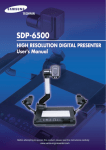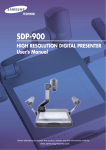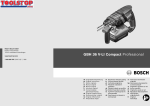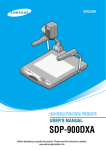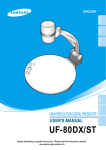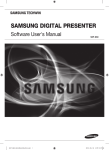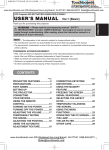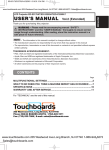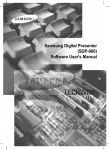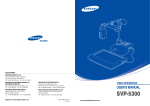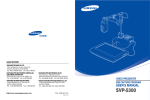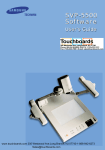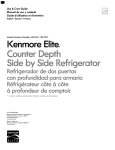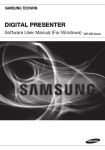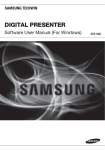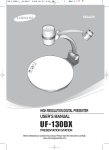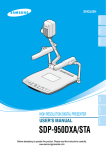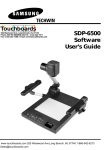Download Adjusting your image - Ferris State University
Transcript
www.touchboards.com 205 Westwood Ave.Long Branch, NJ 07740 1-866-942-6273 [email protected] Special features Thank you for purchasing this product. This product is a high resolution video presenter that can project all kinds of data on a PC monitor, a TV, or a projector with simple manipulations. 12X professional zoom lens and 3X digital zoom (can be used for the materials with sizes from A4 to film) By adopting 12X super optic angle zoom lens, it is possible to shoot all materials from the size of a film to A4 size. Adopted 850,000 pixels CCD By adopting 1/3 inch PS type CCD, high resolution and excellent color reappearance are realized. Can control USB and RS-232 By using USB, it is possible to view or store the image in a PC and control the functions of the set. Also it is possible to control the set by using RS-232C port. Output modes from SVGA to XGA It supports various output modes from SVGA to XGA that it can be connected to all kinds of projectors. Remote controller is a standard feature Remote controller is supplied as a standard feature for the product so that it can be manipulated from a distance. Thus it is very convenient during a conference. TV output mode By adopting TV output mode, monitoring and conference data can be recorded through VTR. Features Various image control Digital features on your Digital Presenter provide useful and various image controls including: - Negative/Positive image conversion - Brightness and Red/Blue color control - Image rotation - Image save/recall - Image freeze - Image divide Input source selection You can quickly switch between your computer presentation and your document presentation with the INT/EXT button on the control panel or on the remote controller. Custom user settings To avoid any interruption of presentation to reset the digital presenter, you can preset up to 4 customized settings in the memory and simply recall it during the presentation. Support to GUI menu system SDP-900DXR support to GUI menu system to control various function of digital presenter with mouse operation. Contents Product features and structure Safety precautions..................................................................5 Uses of digital presenter ........................................................6 Supplied accessories .............................................................7 Names and functions of each part ........................................8 Front side............................................................................8 Main control panel ............................................................10 Terminals at the back .......................................................11 On the remote controller ...................................................12 Operation methods Set preparation......................................................................14 Connecting to output device ...............................................15 TV, PC Monitor or Projector..............................................15 Desktop computer.............................................................16 Computer ..........................................................................17 PS/2 Mouse ......................................................................17 Using the presenter ..............................................................18 To show the image received from external device ...........18 To project an object on the digital presenter.....................20 Adjusting your image ...........................................................23 Adjusting your image with GUI............................................28 Image section ..................................................................28 Digital section ...................................................................31 Miscellaneous section.......................................................35 Exit section .......................................................................37 Changing your image with Draw ........................................38 Before requesting service Storage...................................................................................41 Trouble shooting...................................................................43 Fuse and battery replacement .............................................44 Specifications........................................................................45 Safety precautions Follow these safety instructions when setting up and using your Digital Presenter: 1. Do not place the presenter on an unstable cart, stand, or table 2. Do not use the presenter near water or sources of heat. 3. Use the type of power source indicated on the presenter. If you are not sure of the power available, consult your dealer or power company. 4. Place the presenter near a wall outlet where the plug can be easily unplugged. 5. Take the following precautions for the plug. Failure to comply with these precautions could result in sparks or fire: Do not insert the plug into an outlet with dust present. Insert the plug firmly into the outlet. 6. Do not overload wall outlets, extension cords, or integral convenience receptacles. This can cause fire or electric shock. 7. Do not place the presenter where the cord can be walked on. It may result in fraying or damage to the plug. 8. Unplug the presenter from the wall outlet before cleaning. Use a damp cloth for cleaning. Do not use liquid or aerosol cleaners. 9. Do not block the slots and openings in the presenter case. They provide ventilation and prevent the presenter from overheating. Do not put the presenter on a sofa, rug, or other soft surface or in a built-in installation, unless proper ventilation is provided. 10. Never push objects of any kind through cabinet slots. Never spill liquid of any kind into the presenter. 11. Except as specifically explained in this User's Manual, do not attempt to service this product yourself. Refer all servicing to qualified service personnel. Opening or removing covers may expose you to dangerous voltages and other hazards. 12. Unplug the presenter during lightning storms or when it will not be used for extended periods. 13. Do not place the presenter and remote controller on top of heat-producing equipment or in a heated place, such as a car. 14. Unplug the presenter from the wall outlet and refer servicing to qualified service personnel under the following conditions: • When the power cord or plug is damaged or frayed. • If liquid has been spilled into the presenter, or it has been exposed to rain or water. • If it does not operate normally when you follow the operating instructions, or if it exhibits a distinct change in performance, indicating a need for service. • If it has been dropped or the cabinet has been damaged. FCC Compliance Statement This equipment has been tested and found to comply with the limits for a class A digital device, pursuant to part 15 of the FCC Rules. These limits are designed to provide reasonable protection against harmful interference when the equipment is operated in a commercial environment. This equipment generates, uses, and can radiate radio frequency energy and, if not installed and used in accordance with the instruction manual, may cause harmful interference to radio communications. Operation of this equipment in a residential area is likely to cause harmful interference in which case the user will be required to correct the interference at his own expense. Uses of digital presenter Conference Detailed information in a report, form, table, etc. as well as a three dimensional object, such as a model, can be projected on a screen clearly that all the participants can focus on the same topic during a conference. Thus it is very helpful for an effective progress of a conference. Education It can be used as an audiovisual tool for printed materials, such as text books, as well as audiovisual materials, educational materials, and especially for students' art works. Medicine and science areas Advertisement and design areas It is possible to present various visual data including slides and X-ray film etc. at a medical conference or a doctors' association in the order of file. It is useful in design area where visualization is necessary. It is possible to project catalogs and slides, thus the effect of a job can be checked easily. Demonstration or exhibition By connecting to a large projector, it can produce dynamic images at a new product demonstration, an exhibition, or an event. Supplied accessories When you unpack your Digital Presenter, make sure that you have all these components. User's Manual C-Composite cable S-video cable Remote controller Power cable PS/2 Mouse Lens cap PC Monitor cable USB Cable SDP-900DXR program etc. Dust cover Option Name and function of each part Front side Lens Can rotate to the front and back. Main support Main lock button Press to move the main support. Lamp unit (Upper lamp) Document plate (built-in light box) Main control panel (see next page) IR Sensor Name and function of each part Main control panel The buttons on the main control panel can be found in the remote controller. These buttons perform the same functions. POWER MODE Use this to turn the power on or off. Use this to select the desired resolution for the video output device(PC monitor, projector) connected to this product. FREEZE Use this to freeze the image. INT / EXT AWC Use this to control the color automatically. Use this to select internal or external image INT: to view the image on this product. EXT: to view the VGA output from another device such as a PC monitor or a projector by connecting it to this product. ZOOM Use this to control the size of an object projected on the screen. LAMP Use this to turn the upper lamp or light box on or off. APERTURE Use this to control the sharpness of the output image. ROTATE Use this to rotate the image. AF Use this adjust the focus automatically. IRIS Use this to control the brightness of the image by using the iris. Name and function of each part Terminals at the back POWER INPUT TERMINAL MOUSE Use this to connect the power cable. (100 - 240V, free voltage) Use this to connect PS/2 Mouse. (See page 17.) VGA VIDEO INPUT 1,2 Connect this to the VGA output terminal of another device by supplied PC cable. When external input menu is selected, the image is shown through the VGA out terminal. VGA VIDEO OUTPUT 1,2 Connect this to the RGB input terminal of a PC monitor or a projector by supplied PC cable. RS-232C: COMPUTER CONNECTION TERMINAL Use this to connect RS-232C cable. USB: COMPUTER CONNECTION TERMINAL Use this to connect USB cable when transmitting image by USB port. S-VIDEO OUTPUT This is the video output terminal connecting to a TV that has S-video input terminal. LCD OUTPUT This is the video output terminal connecting to a LCD monitor. TV OUTPUT Connect this to the TV input terminal. Connect this to view the image projected on the TV screen. Even when the external input menu is selected, only the image on the main unit is displayed on TV output terminal. Name and function of each part On the remote controller POWER ROTATE Turns power on or off. Use this to rotate the image by 90˚, 180˚, 270˚, 0˚. INT/EXT Allows to choose the signal input to be displayed. WIDE/TELE NEGA/POSI • Enlarges the image size. • Reduces the image size. Switches for negative or positive film. IRIS+ / IRISTurns the upper lamps and/or lightbox on or off. • Opens iris to increase the brightness. • Closes iris to decrease the brightness. FOCUS EXIT Allows to focus an object. F: Used to focus an object which is in the far distance. N: Used to focus an object being close. Stops current function and return to the normal mode. LAMP NTSC/PAL Switches Video output mode to NTSC or PAL. RED/BLUE/AWC Adjusts the image color. R +/-: Adjusts the red color. B +/-: Adjusts the blue color. AWC: Adjusts color automatically. PRESET • Saves the customized user setting values. • Activates the preset user settings. SAVE/RECALL AF Use this to adjust the focus automatically. • Saves the projected image into the memory of this unit. • Recalls the image from the memory. APERTURE Controls the sharpness of the output image. FREEZE Keeps the current image on the screen. MODE Allows to choose the resolution of the VGA output device connected to the Digital Presenter. XGA(1024x768), SVGA(800x600) DIVIDE Divides the screen to show both of the current image and the image recalled from the memory simultaneously on one screen or to see all the images in the memory(Up to 8 frames) on one screen. SHIFT Shifts the recalled image shown in the divided screen from the left to right to show the hidden portion of the image. Set preparation Press the main lock button and raise the main support Raise the lamp unit until it is convenient for use, and set it to the center of the document plate. Adjust the angle of the lamps properly. Turn the lens area to face downward. Remove the lens cap. Plug the power cord in. Connecting to output device TV, PC Monitor or Projector Connect a TV, PC monitor or Projector to this presenter to display the projected image using the AV cables, S-video cable or PC monitor cable. Connection Connecting to output device Desktop computer For SDP-900DXR, connect a desktop PC using USB cable and install the supplied SDP-900DXR program. You can see the projected image on the PC monitor and control the image as a graphic file using the program. RS-232C connection is available for advanced user. If you connect a PC with RS-232C cable, you should set up your PC and make your own program to control the projected image on PC. Ask your dealer for further details. USB connection RS-232C connection Connecting to output device Computer If you connect computer through VGA IN port, you can receive video signal from the computer. Connection PS/2 Mouse If you connect PS/2 mouse through MOUSE port, you can control various function of digital presenter. (See page 28.) Using the presenter To show the image received from external device Set up your digital presenter properly. (See page 14.) Connect the input device from which you want to receive the image and the output device in which you want to show the image. (See pages 15 through 17.) Turn the power of the input and output device, and the digital presenter on. Using the presenter Choose the video source with the INT/EXT button of the presenter. • Each time you press the button, the display shows EXT1 OUT, EXT2 OUT, INT OUT. • EXT1 OUT, EXT2 OUT View the image from an external VGA output device through a PC monitor or a projector connected to the digital presenter. • INT OUT Choose this mode to show the image through the lens of the digital presenter. Open the image on the computer. Now you see the image through a PC monitor or a projector. Using the presenter To project an object on the digital presenter Set up your digital presenter properly. (See page 14.) Connect to a TV, a PC monitor, a projector to display the image. (See page 15.) Turn the power of the output device and the digital presenter on. Place the object on the lightbox, and adjust the head to face the object. Using the presenter Select a proper lighting source with the LAMP button of the presenter. Each time you press the button, upper lamps on, lightbox on, then all lighting off. Upper lamp. Use the upper lamps to project paper document and other material, and use lightbox lamp to project transparencies. Lightbox Remove or attach the adapter lens according to the objected. Rotate the lens to remove or attach it. • Remove the adaptor lens in the camera mode. (possible focal length: 60cm ~ ∞) • Attach the adaptor lens to view a material or a document or a film placed on the document plate. (Possible focal length: 200mm ~ 360mm) • Beyond the possible focal length mentioned above, it might be out of focus. So pay attention to the distance between the object to be viewed and the main unit and whether the adaptor lens is attached. Using the presenter Focus on the object. • Auto focus control: Press AF • Manual focus control: press [Focus F] or [Focus N] to adjust. You see the image on the TV, the PC monitor or the projector. • To use versatile image control features, see pages 23 through 27. Adjusting your image Use the control buttons on the remote controller or on the control panel of the presenter to adjust the projected image. Some of the main features are described below: Adjusting image size Press WIDE or TELE button on the remote controller to reduce or enlarge the image size displayed on the screen. You can also use ZOOM or ZOOM button of the presenter to achieve the same result. Adjusting brightness Press IRIS image. button on the control panel or IRIS + button on the remote controller to lighten the overall Press IRIS overall image. button on the control panel or IRIS - button on the remote controller panel to darken the Adjusting your image Adjusting image color For automatic color adjustment, press AWC button. If you want fine level adjustment, press BLUE + / - or RED + / - button on the remote controller button to increase or decrease blue or red color factor manually. Hint: To obtain the best result, put the camera lens facing the white paper and press AWC button. Positive and negative switching Press NEGA/POSI button. Each time you press the button, POSI or NEGA appears alternately on the screen. Set to POSI to see normal object and set to NEGA to see negative film. Image sharpness control Press APERTURE button to control the sharpness of the output image of this product. - APERTURE ON: For a material mostly with words. - APERTURE OFF: For a material with many pictures or colors. Adjusting your image Image rotate control For image rotation, press ROTATE button. To rotate the image by 90˚, 180˚, 270˚, 0˚, press ROTATE button Saving image in memory You can save the image up to 8 frames into your digital presenter's memory. After saving, you will be able to recall it. To save the image into the memory, press SAVE button and specify the memory location within 3 seconds using the number keys from 1 through 8. If you want to recall the saved image from memory, press RECALL button and press the memory location number wihin 3 seconds. If you press and hold down RECALL button, all images saved in memory are displayed one by one. If you want to exit from the recall mode, press EXIT button. The memory location numbers are printed on the right side of these buttons. For example, if you want to save the image into memory location 7, press SAVE then press AF button printed 7 at right side. • If you turn the power off, all the saved images will be lost. • Digital zoom picture is not saved, therefore when you press SAVE under Digital zoom mode, the digital presenter automatically returns to the maximum optical zoom state. Adjusting your image Screen 2 divide and image shift You can see both the image of an object currently projected and the image saved in memory simultaneously on one screen. Press DIVIDE button and press the memory location number within 3 seconds to recall the image you want to see. To cancel this mode and return to normal mode, press EXIT button. The digital zoom is not available in DIVIDE mode, therefore when you select DIVIDE mode under digital zoom mode, the digital presenter automatically returns the right live picture to the maximum optical zoom state. You can see the image of an object currently projected at right side. The recalled image from memory appears at left side. Press SHIFT button to shift the image from right to left. Each time you press the button, a third of the image will be moved from right to left. 3x3 Multi-Screen You can see all the images saved in memory simultaneously on one screen and choose one to display it. Press DIVIDE button for 2 seconds or more, then all the images saved in memory are displayed on the screen. To cancel this mode and return to normal mode, press EXIT button. When you want to see one of them, press the number button to recall it. For example, if you want to see the image in memory location 3, press BLUE + button and the image is displayed on the screen. Adjusting your image Saving custom user setting After you adjust feature value, you can save the value for next time use. You can save up to 4 different custom user settings. (You can save the setting on the Zoom, Focus, Iris, Lamp state and Color level buttons.) To save the current value, press SAVE button and specify the memory location within 3 seconds using the number keys from 1 through 4. To recall your custom setting, press the ACTIVE button and press the memory location number within 3 seconds. The memory location numbers are printed on the right side of these buttons, For example, if you want to save the feature into memory location 4, press SAVE then press FOCUS N button printed 4 at right side. Adjusting your image with GUI SDP-900DXR support to GUI menu system to control various function of digital presenter with mouse operation. To use GUI menu system, first of all, mouse device (PS/2 type) must be connected to mouse control terminal, if it is connected with success, mouse pointer will be appeared on the screen. And then, click the right mouse button, GUI main menu is appeared on the screen, and GUI menu system is activated. When [Exit] menu is clicked, GUI main menu disappears and only the mouse pointer remains displayed. Menu and Functions Image section Image menu deals with various adjustment function of on-screen image. Adjusting your image with GUI Focus Allow to focus an object in the far / near distance, or automatically. Holding down [Far]/[Near] menu with the left mouse button, focus is activated. Click [Auto] menu to auto focus function. Zoom Allow to enlarge or reduce the image size. Holding down [Tele]/[Wide] menu with the left mouse button, zoom is activated. Bright Allow to open IRIS to increase the brightness or close IRIS to decrease the brightness. Holding down [Up]/[Down] menu with the left mouse button, lens iris is activated. Adjusting your image with GUI Red / Blue Allow to adjust image color through the red/blue gain control Holding down [Up]/[Down] menu with the left mouse button, red/blue gain control is activated. AWC Allow to adjust image color automatically through automatic white balance control Click [AWC] menu with the left mouse button, AWC function is executed once. Adjusting your image with GUI Digital section Digital menu deals with various digital image processing function. Freeze Allow to keep the current image on the screen. Click[Freeze] menu with the left mouse button, freeze mode is activated and [Freeze] menu turns checked state. To release freeze mode, click [freeze] menu again or click [Cancel] menu with the left mouse button (and then [Freeze] menu turns unchecked state). Rotate Allow to rotate the image by 0˚(Off), 90°, 180°, 270°. Click [0°/90°/180°/270°] menu with the left mouse button, image is rotated by user’s request and menu turns checked state following current status of image. Adjusting your image with GUI Save / Recall Allow to save the projected image into the memory of digital presenter or recall the image from the memory. To save / recall the image with the proper save number, Click [numbers] menu with the left mouse button, current image is saved into or recalled from memory. Adjusting your image with GUI Divide Allow to divide the screen to show both of the current image and the image recalled from the memory simultaneously on one screen. Click [numbers] menu with the left mouse button, screen is divided and selected number of image is recalled from memory and activated in menu. Shift Allow to shift the recalled image shown in the divided screen from the left to right to show the hidden portion of the image. Click[Shift] menu with the left mouse button, image is shift from left to right step by step each request in the divide mode. Adjusting your image with GUI 3x3 Multi Allow to see all the images in the memory (up to 8 frames) on one screen. Click [3x3 Multi] menu with the left mouse button, 9 divide mode is activated and GUI menu disappeared. If you click the image number on screen, select image will be expanded to full screen and GUI menu is appeared on the screen. To Release 3x3 Multi mode, click the center image. Cancel Allow to stop current image processing function and return to normal mode. Click [Cancel] menu with the left mouse button, all digital function is released. Adjusting your image with GUI Miscellaneous section Misc menu deals with miscellaneous function of digital presenter. Preset Save / Exe Allow to save the customized user setting values or to activate the preset user setting. Click [numbers] menu with the left mouse button, current setting value is saved to flash ROM or load setting value from flash ROM. Adjusting your image with GUI NEGA Effect Allow to switch for negative / positive image (default : positive). Click [NEGA Effect] menu with the left mouse button, current image turns negative image and menu turns checked state. To return positive image, click [NEGA Effect] menu again (and then menu turns unchecked state). Aperture Allow to control the sharpness of the output image (default : On) Click [Aperture] menu with the left mouse button to turn on/off aperture mode. (Image mode / Text mode) Video Out Allow to switches video output mode to NTSC or PAL. Click [NTSC/PAL] menu with the left mouse button, video mode is switched to current value. Adjusting your image with GUI Lamp Allow to turn the upper lamps or lightbox on or off. Click [All off/Upper/Lower] menu with the left mouse button, lamp mode is switched to current value. Exit section GUI main menu disappears and only the mouse pointer remains displayed. Tips : Drag and Drop Function GDI main menu can take any position of screen using Drag and Drop. First of all, click the moving point of main menu, and then drag and drop to any position of screen what you want. 1. Click the moving point image 2. Drag the GUI main menu 3. Drop the GDI menu Changing your image with Draw SDP-900DXR supports to GUI Drawing system to draw straight lines, freehand lines, rectangular on the screen with mouse operation. To use GUI Drawing system, first of all, GUI menu system and [Freeze] or [Recall] function must be activated. Then Draw menu is now being activated. (See page 28) When [Draw] menu is clicked, GUI Draw toolbar is appeared on the screen and GUI main menu disappeared. [1] Exit Button [5] Line Width Selection [2] Tool Selection [3] Foreground / Background Color Panel [4] Foreground / Background Color Palette Changing your image with Draw Exit Button Use the Exit button ( full screen. ) to exit GUI Drawing system to normal mode, or clear all the user’s images on the Tool Selection Use the Line Width Selection to set the line width to between 1 and 4 pixels. Drawing the single line To draw a Single line, Click the single line icon and then, 1) Position the cursor on the screen where you want the line to start. 2) Press and hold the left/right mouse button. 3) Drag the cursor. 4) To end the line, release the mouse button. SDP-900DXR creates the line. Drawing the rectangular To create a rectangular, Click the rectangular icon and then, 1) Place the cursor at a corner of the area you want to select. 2) Click and drag the mouse until the selection is the size you want. 3) Release the mouse button. Drawing the freehand line To create a freehand line, Click the freehand line icon and then, 1) Position the cursor on the image where you want the line to begin. 2) Press and hold the left/right mouse button. 3) Drag the cursor on the path you want the line to take. 4) Release the mouse button. Eraser Tool 1) Click the Eraser tool icon and then the cursor changes to the erasing rectangular. 2) Move the cursor over the line and click to delete the line. Changing your image with Draw Foreground / Background Color Panel There are two active colors in GUI Drawing System, the foreground (left mouse click) and background(right mouse click) colors. You can change the brush colors by selecting new foreground and background solid colors using the Color Palette. Foreground / Background Color Palette Use the Color Palette to select the colors that you want to draw the line. Move the cursor over the available colors panel. Left-click to select a foreground color, Right-click to select a background color. The two boxes above the Color Panel display the respective colors. There are six colors to be selected, red, yellow, green, cyan, blue and magenta. Line Width Selection Use the Line Width Selection to set the line width to between 1 and 4 pixels. Storage Turn the power off and unplug the power cord. Attach the lens cap. Turn the head upside down. While you pull the main lock button toward the front of the presenter, fold the head completely. Fold the lamps on both sides completely. Trouble shooting No image appears - Check if the resolution of the output device corresponds to that of the digital presenter. (For example, when the maximum resolution of a projector is SVGA and if the digital presenter is set to XGA, then no image appears.) - Check if the input selection of the output device is appropriate. - Check if the iris control is adequate. - Check if the VGA cable is connected to the VGA output terminal correctly. - Check if there is any problem with the fuse. - Check if the lens cap is removed. No communication between the PC and USB. - Make sure the operating system is Windows 98 or later. It doesn't work on Windows 95. - For other detailed information, please refer to the program manual supplied with the product. No image from a slide film or a negative film. - Check if the light box is turned on. - Adjust the lens to face the film directly. - Check if the NEGA/POSI button is selected properly. remote controller is not working. - Check the battery of the remote controller. Replace it with a new one. The image is out of focus. - Check if the adaptor lens is attached properly for the purpose. (See page 21.) - Check if the distance from the object is too short. When you use GUI, the mouse is not seen or does not work normally. If there are problems, please contact the store you purchased the product or our distributor nearest you. - Check the contact condition of mouse port and make sure it's mouse offered by Samsung Techwin. (It may not work if it's not mouse offered by Samsung Techwin.) Fuse and battery replacement Fuse replacement Battery replacement Take out the fuse holder . Open the battery compartment lid at the back of the remote controller. Take out the fuse and replace it. Insert the batteries so that their with a new one. • Fuse type:2A, 250V Put the fuse holder back. • Battery type:AAA type 1.5V Close the lid. Specifications Note: Spscifications are subject to change without notice. Specifications Lens Shooting Area Optical system Zoom Focus Iris Upper Illumination system Lower Pick-up Device/ Effective pixel Frame rate Sync system VGA output Video output Video PC connection White Balance Positive / Negative Freeze Input terminals Output terminals NTSC / PAL Remote controller GUI(Graphic User Interface) Input selection On-screen display Image freeze Image save Image recall Image divide Image rotation Image transfer to computer Preset function USB RS-232C Application software Operating temperature/ Humidity Power General Dimensions(mm) Weight Accessories Description F=1.5(Wide)~2.1(Tele) f=5.2~66.5, 12x power zoom Max: 298 x 217mm, Min: 21 x 16mm Powered (12X), Digital(3X) Powered (Auto Foces/Manual) Auto (with fine level adjustment) Attach to the side arm of the main unit Light box (built-in main unit) 1/3" 850,000 pixels PS CCD / 1034(H) x 779(V) 15 frame/sec Internal sync. 1024 x 768(XGA) RGB color, 800 x 600(SVGA) RGB color. C-Video VBS 1.0Vp-p / 75Ω (unbalance) S-Video Y: 1.0Vp-p / 75Ω (unbalance) C: 0.286Vp-p / 75Ω (unbalance) Manual / Auto (one touch type) Selectable built-in VGA:2 VIDEO:1, VGA:2, USB:1, RS-232C:1, S-Video:1, LCD:1 Selectable Supplied Supplied 3 channels (Internal: 1, External: 2) Available Available Available (8 frames) Available (8 frames) Available (2divide of 9 divide) Available Available (USB: full, 1/4, 1/16 mode) Up to 4 user settings built-in SET control Viewer (for Windows 98, 98SE, ME, 2000 Professional, XP & Mac OS X), TWAIN Driver (for windows) +5˚C ~ +35˚C, 30% ~ 90% AC 100V ~ 240V Free Voltage, 50/60Hz, 50W In-use: 676(W) x 580(H) x 558(D) Storage: 533(W) x 167(H) x 582(D) 11.5kg Remote controller, Cables, etc. Memo HEAD OFFICE : SAMSUNG TECHWIN CO., LTD 145-3 Sangdaewon 1-Dong, Jungwon-Gu, Sungnam, Kyungki-Do,Korea 462-121 TEL : 82-31-740-8137~8141 FAX : 82-31-740-8145 U.S.A OFFICE : SAMSUNG OPTO-ELECTRONICS AMERICA, INC. 40 Seaview Drive, Secaucus N.J.07094, U.S.A TEL : 201-902-0347 FAX : 201-902-9342 www.samsungpresenter.com www.samsungtechwin.com P/No.: 6806-0400-01B















































